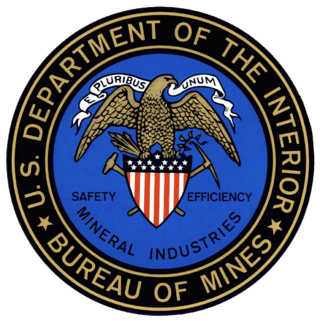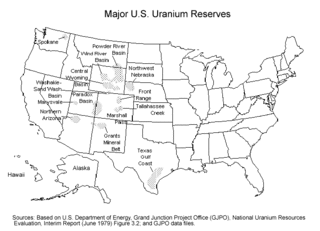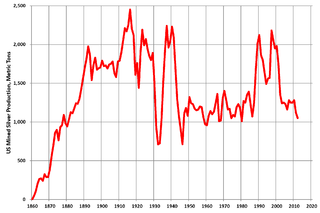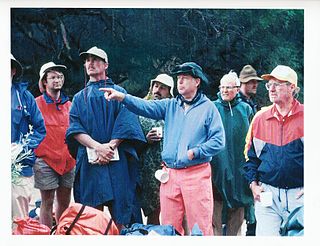Related Research Articles

Mining is the extraction of valuable geological materials and minerals from the surface of the Earth. Mining is required to obtain most materials that cannot be grown through agricultural processes, or feasibly created artificially in a laboratory or factory. Ores recovered by mining include metals, coal, oil shale, gemstones, limestone, chalk, dimension stone, rock salt, potash, gravel, and clay. The ore must be a rock or mineral that contains valuable constituent, can be extracted or mined and sold for profit. Mining in a wider sense includes extraction of any non-renewable resource such as petroleum, natural gas, or even water.

Mining in the engineering discipline is the extraction of minerals from the ground. Mining engineering is associated with many other disciplines, such as mineral processing, exploration, excavation, geology, metallurgy, geotechnical engineering and surveying. A mining engineer may manage any phase of mining operations, from exploration and discovery of the mineral resources, through feasibility study, mine design, development of plans, production and operations to mine closure.

The General Mining Act of 1872 is a United States federal law that authorizes and governs prospecting and mining for economic minerals, such as gold, platinum, and silver, on federal public lands. This law, approved on May 10, 1872, codified the informal system of acquiring and protecting mining claims on public land, formed by prospectors in California and Nevada from the late 1840s through the 1860s, such as during the California Gold Rush. All citizens of the United States of America 18 years or older have the right under the 1872 mining law to locate a lode or placer (gravel) mining claim on federal lands open to mineral entry. These claims may be located once a discovery of a locatable mineral is made. Locatable minerals include but are not limited to platinum, gold, silver, copper, lead, zinc, uranium and tungsten.

For most of the 20th century, the United States Bureau of Mines (USBM) was the primary United States government agency conducting scientific research and disseminating information on the extraction, processing, use, and conservation of mineral resources. The Bureau was abolished in 1996.

Uranium mining in the United States produced 224,331 pounds (101.8 tonnes) of U3O8 in 2023, 15% of the 2018 production of 1,447,945 pounds (656.8 tonnes) of U3O8. The 2023 production represents 0.4% of the uranium fuel requirements of the US's nuclear power reactors for the year. Production came from five in-situ leaching plants, four in Wyoming (Nichols Ranch ISR Project, Lance Project, Lost Creek Project, and Smith Ranch-Highland Operation) and one in Nebraska (Crowe Butte Operation); and from the White Mesa conventional mill in Utah.

In the United States, gold mining has taken place continually since the discovery of gold at the Reed farm in North Carolina in 1799. The first documented occurrence of gold was in Virginia in 1782. Some minor gold production took place in North Carolina as early as 1793, but created no excitement. The discovery on the Reed farm in 1799 which was identified as gold in 1802 and subsequently mined marked the first commercial production.

Silver mining in the United States began on a major scale with the discovery of the Comstock Lode in Nevada in 1858. The industry suffered greatly from the demonetization of silver in 1873 by the Coinage Act of 1873, known pejoratively as the "Crime of 73", but silver mining continues today.

Uranium mining in Colorado, United States, goes back to 1872, when pitchblende ore was taken from gold mines near Central City, Colorado. The Colorado uranium industry has seen booms and busts, but continues to this day. Not counting byproduct uranium from phosphate, Colorado is considered to have the third largest uranium reserves of any US state, behind Wyoming and New Mexico.

Uranium mining in Arizona has taken place since 1918. Prior to the uranium boom of the late 1940s, uranium in Arizona was a byproduct of vanadium mining of the mineral carnotite.

Fred F. Meissner was an American geologist and engineer who contributed to the fields of geology, geophysics, engineering, petroleum engineering, geochemistry, mineralogy, physics, mining, economic geology, and fishing.
Uranium mining in New Mexico was a significant industry from the early 1950s until the early 1980s. Although New Mexico has the second largest identified uranium ore reserves of any state in the United States, no uranium ore has been mined in New Mexico since 1998.

The Midnite Mine is an inactive uranium mine in the Selkirk Mountains of the state of Washington that operated from 1955 to 1965 and again from 1968 to 1981. Located within the reservation of the Spokane Tribe of Indians, it is approximately 8 miles (13 km) from Wellpinit, Stevens County. The mine was listed as a Superfund site under the Comprehensive Environmental Response, Compensation, and Liability Act of 1980 (CERCLA) on May 11, 2000. In addition to elevated levels of radioactivity, heavy metals mobilized in uranium acid mine drainage pose a potential threat to human health and the environment.

A geologist is a scientist who studies the structure, composition, and history of Earth. Geologists incorporate techniques from physics, chemistry, biology, mathematics, and geography to perform research in the field and the laboratory. Geologists work in the energy and mining sectors to exploit natural resources. They monitor environmental hazards such as earthquakes, volcanoes, tsunamis and landslides. Geologists are also important contributors to climate change discussions.

The New Mexico Environment Department (NMED) is a state government agency responsible for "protecting and restoring the environment of the state of New Mexico to foster a healthy and prosperous New Mexico for present and future generations," according to its mission statement. This organization believes that New Mexicans must have fair treatment and meaningful opportunities for involvement in the development, implementation and enforcement in several laws. These include but are not limited to environmental laws and regulations regardless of race, creed, color, national origin, gender, disability, religious or political affiliation, income or educational level. This department is also commitment to equity in the communities they serve guided by the non-discrimination and environmental justice programs. It was established in the Department of the Environment Act (40th Legislature), enacted July 1, 1991, and is a cabinet-level department to oversee the state's environmental laws. Before its creation, these environmental duties were shared by the New Mexico Health Department’s Environmental Protection Division and other government agencies. The department has around 650 employees, and covers such areas as environmental health and protection, air quality, occupational health and safety, radiation control, water management and petroleum storage tank management. New Mexico is committed to the protection of public health.
Mining in the United States has been active since the beginning of colonial times, but became a major industry in the 19th century with a number of new mineral discoveries causing a series of mining rushes. In 2015, the value of coal, metals, and industrial minerals mined in the United States was US$109.6 billion. 158,000 workers were directly employed by the mining industry.

The Mines and Geo-sciences Bureau (MGB) is a government agency of the Philippines under the Department of Environment and Natural Resources (DENR). The MGB is responsible for the conservation, management, development and use of the country's mineral resources, including those in reservations and public lands.

The New Mexico Energy, Minerals and Natural Resources Department (EMNRD) is a state agency in New Mexico tasked with managing and protecting the natural and energy resources of New Mexico.

The Blue Ledge Mine is an inactive underground copper mine that has been classified as a Superfund Site by the Environmental Protection Agency (EPA) due to high concentrations of heavy metals. The mine is located approximately 3 miles south of the California–Oregon border in the Rogue River-Siskiyou National Forest. It is within the Siskiyou Mountain range, and sits near a summit at about 4,800 feet above sea level. The underground mining excavations span over 2 miles, and it is one of the largest mining operations to have existed in the region.

Geological engineering is a discipline of engineering concerned with the application of geological science and engineering principles to fields, such as civil engineering, mining, environmental engineering, and forestry, among others. The work of geological engineers often directs or supports the work of other engineering disciplines such as assessing the suitability of locations for civil engineering, environmental engineering, mining operations, and oil and gas projects by conducting geological, geoenvironmental, geophysical, and geotechnical studies. They are involved with impact studies for facilities and operations that affect surface and subsurface environments. The engineering design input and other recommendations made by geological engineers on these projects will often have a large impact on construction and operations. Geological engineers plan, design, and implement geotechnical, geological, geophysical, hydrogeological, and environmental data acquisition. This ranges from manual ground-based methods to deep drilling, to geochemical sampling, to advanced geophysical techniques and satellite surveying. Geological engineers are also concerned with the analysis of past and future ground behaviour, mapping at all scales, and ground characterization programs for specific engineering requirements. These analyses lead geological engineers to make recommendations and prepare reports which could have major effects on the foundations of construction, mining, and civil engineering projects. Some examples of projects include rock excavation, building foundation consolidation, pressure grouting, hydraulic channel erosion control, slope and fill stabilization, landslide risk assessment, groundwater monitoring, and assessment and remediation of contamination. In addition, geological engineers are included on design teams that develop solutions to surface hazards, groundwater remediation, underground and surface excavation projects, and resource management. Like mining engineers, geological engineers also conduct resource exploration campaigns, mine evaluation and feasibility assessments, and contribute to the ongoing efficiency, sustainability, and safety of active mining projects
References
- 1 2 3 4 5 6 United States (1994). Rhea Lydia Graham nomination : hearing before the Committee on Energy and Natural Resources, United States Senate, One Hundred Third Congress, second session on the nomination of Rhea Lydia Graham, to be Director, Bureau of Mines, Department of the Interior, September 28, 1994. Washington: U.S. Government Printing Office. p. 17. ISBN 0160460484.
- 1 2 3 4 "Board of Advisors | Alumni & Friends | College of Earth, Ocean, and Atmospheric Sciences | Oregon State University". ceoas.oregonstate.edu. Retrieved October 29, 2021.
- ↑ "Diverse Sources | Science, Health and Environment experts available on deadline". diversesources.org. Retrieved February 4, 2019.
- ↑ Graham, Rhea (1977). A Paleomagnetic Study of Recent Sediments in the Santa Barbara Basin. Oregon: Oregon State University.
- 1 2 "Rhea Graham". LinkedIn. Retrieved February 6, 2019.
- ↑ "Who's Who Among African Americans, 18th Ed" . Retrieved February 6, 2019.
- 1 2 Breslin, John A. (February 2010). "One Hundred Years of Federal Mining Safety and Health Research" (PDF). United States Department of Health and Human Services. p. 59,84. Retrieved October 29, 2021.
- ↑ Hearing before the committee on energy and natural resources united states senate. U.S. Government Printing Office. September 28, 1994. pp. 56–88. ISBN 0-16-046048-4.
- ↑ Barr, Stephen (December 4, 1995). "Bureau of Mines Feeling Shafted". The Washington Post . Retrieved October 29, 2021.
- ↑ Swanson, F.J.; Graham, R.L.; Grant, G.E. (September 3–5, 1985). "Some Effects of Slope Movements on River Channels" (PDF). International Symposium on Erosion, Debris Flow and Disaster Prevention: 273–278 – via Oregon State.
- ↑ Mines, Staff of the U. S. Bureau of (June 25, 2015). Dictionary of Mining Mineral, and Related Terms, 2nd Ed, Rhea Lydia Graham, 1996: minerals. Bukupedia.
- ↑ Edwards, John. C. (January 1995). "Mining Publication: Evaluation of Smoke Detectors for Mining Use". Centers for Disease Control and Prevention.
- ↑ Graham, Rhea. "New Books -- Environmental Policy Law--Problems, Cases, and Readings (2nd Ed.) by Thomas J. Schoenbaum and Ronald H. Rosenberg." Ground Water 30.2 (1992): 290. Web.
- ↑ Graham, Rhea. "New Books -- Wasting Away--An Exploration of Waste: What It Is, How It Happens, Why We Fear It, How to Do It Well by Kevin Lynch." Ground Water 30.3 (1992): 469. Web.
- ↑ Graham, Rhea. "New Books -- The Complete Guide to the Hazardous Waste Regulations (Second Edition) by Travis P. Wagner." Ground Water 30.5 (1992): 802. Web.